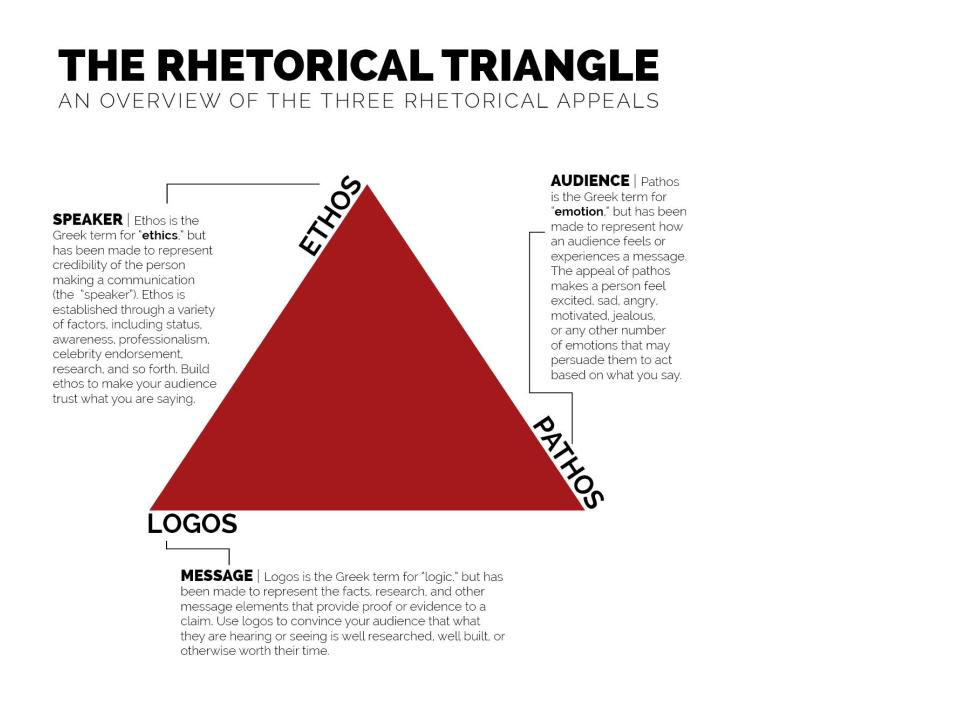Rhetorical situations
==Rhetorical Situations==
- Every time two people exchange information, there is an active "rhetorical situation."
- A rhetorical situation is simply a way to describe the four elements of the information transaction.
- The first and most important element is the "rhetorical artifact." Artifact is a much more general word to describe the container for the author's words.
- In a verbal speech, the artifact would just be the words, but an artifact could also be an email, a text, an advertisement, a movie, a social media post, or anything else that can transfer information.
- Along with the text, there is also the author, the audience, and a context in every rhetorical situation.
- These elements interact with each other within the text, and the purpose of the rhetorical analysis is to analyze those interactions.
- In Aristotle's Rhetoric, he used the elements of a rhetorical situation to develop the "modes of persuasion" or "rhetorical appeals" an author can use to convince an audience of their argument.
- These are ethos, pathos, logos, and kairos.
- The first thing that we need to do for our rhetorical analysis is to isolate each element by looking for these rhetorical appeals.
 ==Text==
==Text==
- When thinking about doing a rhetorical analysis, the most important element is the text itself.
- The text is the body that gives all of the other elements of life.
- It is what the author uses to communicate with the audience and thus will contain all the interactions in the rhetorical situation.
In college writing, "logos" refers to the shape an argument takes.
- A thesis will state the conclusions that the audience should accept.
- Claims and evidence will prove that conclusion.
- Aside from the argument, logos can also refer to sentence structure, word choice, and fallacies.
==Ethos==
- Ethos describes the "credibility" of the author, which can be developed in many different ways.
- The author can demonstrate good sense with practical knowledge about the subject or properly timed expert quotations.
- The author can demonstrate goodwill to the audience by keeping their best intentions in mind and giving them clear indications of value.
- The author can also be virtuous by developing a history of credibility and morals
==Pathos==
- Pathos describes the disposition of the audience.
- In the rhetorical situation, everything is designed for the audience.
- So, when we isolate rhetorical appeals of pathos, we should only look for the moments when the author tries to modify their disposition or exploit it to get a response.
- Authors can play on dispositions in many ways, but generally, it can be isolated by looking for specific word choices.
- appeals to emotion
- .words and phrases to look for:
- emotional
- narrative/descriptive
- jargon
Value
- priorities
- professional work
- expectations
==Questions to consider==
- do they use individuals’ stories to put a face on the problem you’re exploring?
- The context describes the time and place where the information transaction happens.
- When thinking about peer-reviewed papers or term papers, the context is generally the same and will not have a massive impact on the audience.
- However, in other cases, the context will have a huge impact on the audience's disposition, the author's ethos, and the availability and relevance of claims.
- The context of the speech will change the audience's disposition, tone, presentation, and use of evidence
- do they describe a setting or narrative?
- do they use words that describe the context of the rhetorical situation?
==Artifact==
- part of the artifact interacts with the audience
- strictly related to the author= reveals the position of the author
- the echo chamber of disciplines
- increase in value
==Author==
- increase in credibility= increase in ethos
- Describes a rhetorical situation
- list of connections